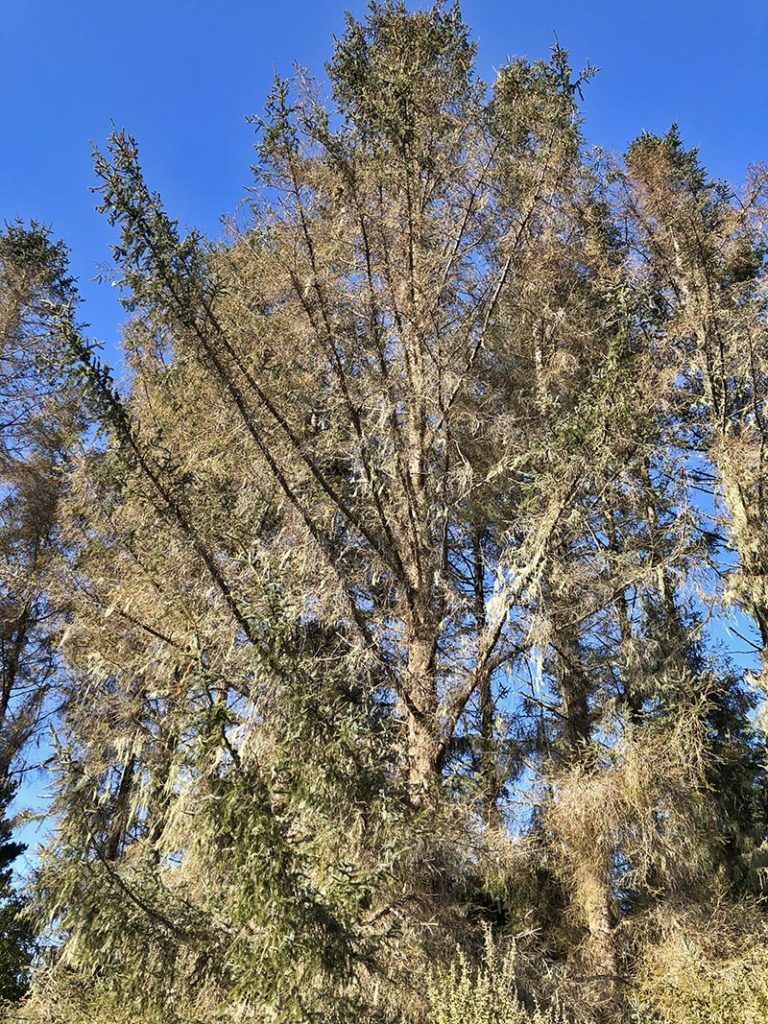Where Highway 101 hugs the Pacific Coast in Humboldt County, north through Del Norte County, Sitka spruce (Picea sitchensis) are loosing needles at an alarming rate. This phenomenon, caused by the non-native green spruce aphid (Elatobium abietinum), grew into a noticeable problem in winter 2019-2020. The aphid thrives during winters with warmer than normal temperatures. Last year’s defoliation was especially severe in Oregon and the aphids continues to move south. Sitka spruce decline in California is in its early stages.
Native and current range

© Ken Gray Insect Image Collection
Native to Northern, Central and Eastern Europe, the original host of Elatobium abietinum is the Norway spruce (Picea abies). From Europe the aphid spread into other regions where P. abies grow on plantations. It has arrived more recently in North America and become established on hosts including Sitka spruce (P. sitchensis), Engelmann spruce (Picea engelmannii) and Colorado spruce (Picea pungens). Around the world the aphids are found on 14 species of Picea and five species of Abies.
Symptoms and description
Plants affected show banded yellowish blotches on the needles first. The needles will then turn completely yellow or brown and eventually drop. Interestingly, new growth is not affected. This phenomenon causes trees to have bare centers and green tips on the branches and tops.
Green spruce aphid takes hold in California

Defoliation in California is limited to areas where Sitka spruce grow on the edge of forests or along highways and roads. Chris Lee, the Forest Health Specialist with the California Department of Forestry and Fire Protection, has been watching the aphid carefully in California. Chris says “On some of the trees in Humboldt and Del Norte Counties, it has defoliated all but the last few meters of crown on the very top. In November, some trees I looked at near Lake Earl were actually putting on new needles at that time and looked like skeletons even though they were completely green.”
The good news, Chris says, is that in Alaska “aphids have also been a problem, but that entomologists have never noticed spruce mortality as a result of the defoliation–the trees always seem to hang on. However, if the temperatures keep increasing, I wonder if that will continue to be the case.”
Other resources
- Spruce aphid from the Pest Management Handbook
- Spruce aphids found on central Oregon Coast from the Daily Astorian. Story by Katie Frankowicz.


Trees don”t “put on new needles”; they extend buds that have embryonic needles inside, and those needles must enlarge on the elongating shoot in order to grow enough to make a meal for any insect. Older needles from prior years and even pretty new ones that are borne upon the lower limbs usually contribute little to the tree as a whole, which may be why “new growth is not affected”.
Incidentally, spruce “galls” on Engelmann spruce and Douglas-fir almost never seem to be attacked in their upper crowns, even when devastated throughout the lower crown. Good material for a master’s thesis.